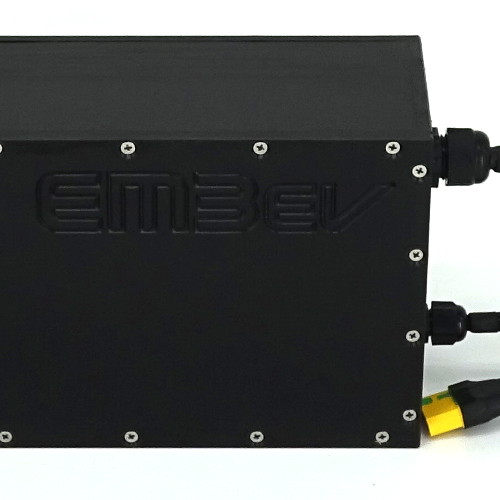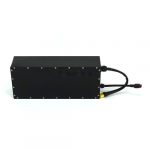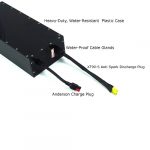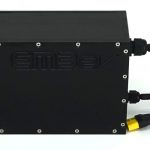EM3ev 52V (14S7P) Hard Case Ebike Battery Pack
From: €558.91 (EUR)
- Description
- Reviews (3)
Description
EM3ev 52V (14S7P) Rectangle Ebike Battery Pack
We now are fitting the 14s7p rectangle battery pack with a Smart BMS and power switch. The Smart BMS allows the cell group voltage, temperature and battery capacity percentage to be monitored via an Android app through a Bluetooth connection. The Smart BMS will balance the cells even at a 90% charge.
Em3ev battery packs include (patented) safety features that you will not find elsewhere (on any Ebike Battery Pack that we are aware of). Our stand out battery pack features are the facts that every single cell in the battery is fused. The signal wires are also fused. This is in addition to the normal battery management system (BMS). The BMS protects the battery against over-charge, excessive charge/discharge current and also balancing.
Our rectangular battery packs are housed in a very robust plastic case. This not only provides serious mechanical protection, but is also water-resistant. We build battery packs (and design/manufacture most of the key component parts on our own high-tech machines). We build our own battery packs, as we want to do things right, we want to do things safe, we want to innovate and because we can.
EM3ev packs are always conservatively/accurately rated, which will help to ensure our packs provide a long and reliable service life. On top of all this, we stand behind our products (1 year warranty) and WE WILL fix any issues that occur (with minimum inconvenience, no cost to the customer and no we do not ask customers to return parts to China!). Here at EM3ev, we are not about hype, spin and self-promotion, our reputation was built the old fashioned way, by happy/satisfied customers.
Specification for each variant of the EM3ev 52V (14S7P) Rectangle Ebike Battery Pack
| Cell Type | Capacity (Ah) | Capacity (Whrs) | Max Cont. Current | Max Burst Current | Weight |
|---|---|---|---|---|---|
| Standard – 22P | 50.4V 14.7Ah | 740Whrs | ~29A | ~44A | ~5.5kg |
| High Energy – PF | 50.4V 20Ah | 1008Whrs | ~40A | ~55A | ~5.7kg |
| High Energy – 33G | 50.4V 21.7Ah | 1094Whrs | ~33A | ~43A | ~5.7kg |
| High Energy – LG MJ1 | 50.4V 23.8Ah | 1200Whrs | ~36A | ~47A | ~5.9kg |
| High Power – 25R | 50.4V 17.2Ah | 864Whrs | ~40A | ~55A | ~5.5kg |
| High Power – 30Q | 50.4V 20.7Ah | 1041Whrs | ~40A | ~55A | ~5.7kg |
| High Energy – Samsung 35E | 50.4V 23.8Ah | 1200Whrs | ~36A | ~47A | ~5.9kg |
| High Energy – Panasonic GA | 50.4V 23.8Ah | 1200Whrs | ~36A | ~47A | ~5.9kg |
Please note we recommend a max of no more than 50A for the Smart BMS. The trip current is set just above 60A.
We offer various Samsung and LG cell types, in addition to the standard ICR18650-22 (NCM cell, 3C rated, approximately 2.1Ah) cell. These new cell types are the High Energy INR18650-33G (NCA Cell, 3C Max rated cell, with approx. 3.1Ah nominal Capacity), Panasonic PF (NCA 2C recommeded Max, 3C Max burst current ~2.85Ah), LG MJ1 (NCA, 3C Max, ~3.4Ah), Samsung 35E (NCA, 3C Max ~3.4Ah) and Panasonic GA (NCA, 3C Max ~3.4Ah). There is also the High Power cells, the INR18650-25R and INR18650-30Q. These are NCA type cells, ~8C rated with Capacity of approximately 2.45Ah (25R) and ~5C rated and capacity of 2.95Ah for the 30Q cell. Regardless of the cell type used, the dimensions of the pack are unchanged.
Please note that when a battery is ordered with a kit, we will make the controller to battery connections plug. This includes a Pre-Charge. If the customer purchases a battery without a controller, we will supply a matching tail which should be linked to your existing controller supply. We use the XT90-S pre-charge connector. It is essential a Pre-Charge is used when connecting to the controller to avoid the large spark that occurs without such a system. This will avoid issues with connectors and the Battery BMS. Various optional chargers are offered.
EM3ev 52V (14S7P) Rectangle Ebike Battery Pack Specs:
- We have a cell level fuse on every single cell in the battery pack (patented design). This will in the event of a serious accident or abuse, cause the affected cells to disconnect and avoid a dangerous situation. There is no way other than cell level fusing to protect against an internal short-circuit in the battery. Neither a good BMS or a pack fuse can protect against an internal short-circuit in the battery. In addition to the cell level fusing, we also implement a pack fuse. Our pack fuse will blow, if for example, the battery discharge lead were shorted out. Therefore, there is no chance that the cell level fuses would blow from an external short-circuit.
- PPTC thermal fuses used on all signal wires. If a fault were to ever occur on any of the small balance wires which run around the battery pack, the fuse simply shuts down the connection and keeps everything safe. Once the fault condition is removed, function returns to normal.
- We use 14S (50.4V, based on 14*3.6V), not 13S (46.8V nominal, based on 13* 3.6V) like everybody else. So that means a working voltage of over 48V most of the time. And it also means that you’re getting that much more capacity than you would have had with an equivalent 13S Pack from somewhere else (7.7% extra versus a 13S equivalent). Our 14S NCM packs have very similar charge and discharge voltages to our 16S A123 packs.
- We conservatively rate the cells as 2.45Ah (SDI, 25R), 2.10Ah (SDI, 22P), 3.10Ah (SDI, 33G), 3.40Ah (LG MJ1), and 2.95Ah (SDI, 30Q). Like with any Li Ion type battery, best long term performance is obtained by not using all of the available capacity all of the time.
- Energy Density of 150Whrs plus for finished pack.
EM3ev 52V (14S7P) Rectangle Ebike Battery Pack Cycle Life and Charging
- Cycle Life estimated at 500-700 cycles (to 80% Retained) with 100% Charge and 100% discharge cycles. Cycle life is extended (possibly doubled) by charging to 90% and limiting discharge to 90%. So if you use 80% of the available capacity (most, but not all of the time). We make it easy to control the Charge voltage with our switching charger. To accurately limit discharge the Cycle Analyst is a great tool. Using continuous High Discharge Rates over the recommended levels will cause cell heating and can shorten cycle life.
- Charge Voltage of 58.8V for 100% charger, 57.4V for 90% Charge. (Our NCM 5A chargers include a switch to charge to 100%, 90% and 50%).
- Maximum Charge Current 8A max (charge connector limited).
EM3ev 52V (14S7P) Rectangle Ebike Battery Pack Weight and Dimensions
- Discharge Current, recommended 30A or less (22P), 35A (33G), 35A (MJ1) 40A+ (25R and 30Q).
- Dimensions: 81mm thick. 324mm long, 140mm wide.
- Weight: 5.5kg (25R and 22P), 5.7kg (30Q, 33G, MJ1).
Lead-Times For Battery Pack
If we don’t have the battery pack already built in stock, the lead time is approx. 5 to 7 working days for us to build one once the order has been placed. We have streamlined our building process and the lead time is now 3 to 4 working days.
3 reviews for EM3ev 52V (14S7P) Hard Case Ebike Battery Pack
Only logged in customers who have purchased this product may leave a review.







michael pettengill (verified owner) –
It’s been almost 3 years since I bought 50V 21.7Ah High-Energy Pack (14S7P-33G). I’m not a heavy user logging kilometers per day, or even week, but my recumbent trike with hub motor and trailer has been my only transport for 5 years. This battery has been a fantastic replacement for the original 36v SLA.
Em3ev reminds me of DEC, my former employer: “everyone knows they have great products, but poor marketing”. No flashy ads, etc, but once I ordered based on the recommendations on several forums, primarily endless-sphere.com, I got email on holiday delay and then shipping, and it arrived in a sturdy box as expected. Wiring the cable up, and connecting to my ebikekit system with drok monitor and shunt got me going after setup with a fantastic power boost.
And I still get a thrill twisting the throttle with the power of electric drive. Didn’t know about the bluetooth monitoring until I saw a few posts in endless-sphere about it. “Everyone knows, but poor marketing”. I see the order page now lists what has been shipping for years. I keep coming back because I want to need more, but the battery from 3 years ago looks just like new.
If I could find a UPS box for 48v to 110vac 60hz, I’d build a Tesla powerwall to go with my Tesla cybertrike at the low em3ev price.
But how bad can the marketing be if “everyone knows…”
Jim Milstein (verified owner) –
I fabricated a cradle to hold this big battery in front of a rear rack I made for a Biktrix Juggernaut Ultra FS. I wanted the bike to have a range greater than mine. So far, no matter how gnarly or how long or how steep, the battery has lots left when I don’t. The bike is heavy but I’m not; so it averages out. The bike has the Bafang Ultra mid-mount motor, which peaks at 1500W. I’ve been there. The builtin battery just goes along for the ride.
My single disappointment is that the smart BMS has no app for my iPhone nor for a Pixel2, whose OS cannot be backed out to an ancient version of Android for which an app is said to exist (thanks, Verizon!). I got the Pixel just for that purpose. Oh well. It will run the latest Android; so, I can swing either way for the hoped-for BMS app.
I have another smart BMS which communicates beautifully with the Xiaoxiang BMS app for iOS. It’s great. I’d love to have all that same battery info bathe my eyes as it does from my off-grid battery and BMS.
Is this a place to talk about ebike “efficiency”? When I first got interested in ebikes, the rule-of-thumb for efficiency was to assume 20 Wh/mile. I quickly discovered that even aggressive riding seldom averaged more than 16 Wh/mile. On maintained roads, paved or gravel, 12 Wh/mile was easily achievable. Can I do better? Yes, much better! Dialing back assistance to 16% of the maximum value and slowing down to an average speed around 15mph, on hilly rides I can easily average 7 to 8 Wh/mile. The bike, tricked out, weighs 100 lb. The rider, old and feeble, weighs 145 lb.
Joseph –
We believe a customer made a new version of the app. It should work with Android 10 and newer. It doesn’t have the log functionality of the older version (2.7) but it does have the cell group data.
https://play.google.com/store/apps/details?id=com.kroko.bmsmonitor&hl=en_IE&gl=US
Jim Milstein (verified owner) –
At long last I got around to installing the BT BMS app on a Pixel 2 running Android 11. This is the whole reason for having the Pixel 2. The Pixel had no trouble seeing the battery, but the app did not see it until I restarted the app. As Joseph said, the info is minimal, but it was sufficient to answer my question, “How are you doing?”
I fully charged the battery to equalize the cells, then rode enough to pull it down to about 95%. The next day I installed the app and messed around until it worked, as described above. The parallel groups had a spread of about 4 mV. I had put several thousand miles on the battery. The BMS app claimed that capacity had declined less than 1% so far. Good enough for me!
By the way, the battery is a high-energy 14s7p. At 1500W, the bike’s Bafang Ultra motor draws 30A. The motor averages much less, ~250W.